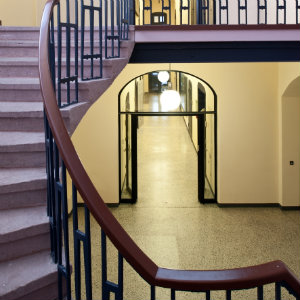

As the founder of the School of Arts and Crafts, Henry van de Velde prepared the way for the Bauhaus-Universität Weimar at the beginning of the 20th century and influenced art instruction in Weimar. His extraordinary spirit for architecture, design and art is rooted to this day in the teachings at Bauhaus-Universität Weimar and is visible in multiple places in Weimar.
During his time in Weimar, Henry van de Velde not only taught artisanal handicrafts, but also was active as an architect. He planned and erected the buildings for the Weimar Saxon-Grand Ducal Art School as well as the famous Van de Velde building, at that time the School of Arts and Crafts. Both buildings are part of the art school ensemble and belong to the Bauhaus-Universität Weimar.

Today they house the Faculties of Art and Design and Architecture as well as the President’s (Rector) Office. The Main Building of the university and the Van de Velde building were renovated in 1999 and 2009, respectively, and are now counted among UNESCO’s World Heritage Sites. Van de Velde leads the School of Arts and Crafts until its closure in 1915. A few years later it was reopened—under the direction of Walter Gropius, whom Van de Velde suggested as his successor.

With Gropius, the State Bauhaus was founded, combining the Weimar Saxon-Grand Ducal Art School and the School of Arts and Crafts with a new programme. The basis of the Bauhaus-Universität Weimar’s present-day orientation developed under Gropius’ leadership. It follows his idea of »unity in handicrafts, art and technology«, which is deeply rooted in the structures of the Bauhaus-Universität Weimar and each of the faculties, from Architecture to Civil Engineering, from Media to Art and Design. Those interested in learning more can get a feel for the development of the Bauhaus on the Bauhaus-Walk.

As a supplement to the Bauhaus-Walk, the Van-de-Velde Walk gives a multi-faceted view of the artist’s works in Weimar. You can find more information about the School of Arts ensemble and Van de Velde’s significance for the city of Weimar and the Bauhaus-Universität Weimar here.
